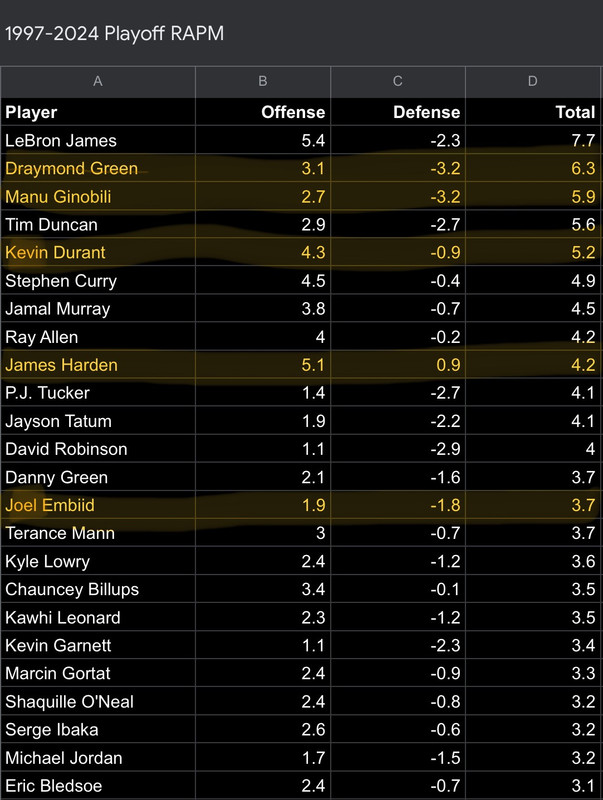homecourtloss wrote:lessthanjake wrote:homecourtloss wrote:
It's good data to have especially for the heavy minutes players. These type of career numbers look pretty good when you then talk about single your peaks.
Additionally, I see people using single year playoffs EPM without anybody saying "I've got major concerns..."
Single-playoff EPM is definitely more reliable than single-playoff RAPM (or single-playoff on-off), since the whole point of the measure is to use box and tracking data to make the measure much more stable in small samples. That said, playoff EPM is definitely not as reliable as regular-season EPM (or multi-season RAPM or other similar measures), because the sample-size issues are still more of a problem. I’m not even sure that playoff EPM is better than pure box data like playoff BPM. If it is, it’d probably be more because it incorporates tracking data than because the impact component improves accuracy in that small a sample. If there were somehow a much more reliable form of single-playoff data than what we have, then I’d definitely use that instead. But there’s not, because the playoffs are just a small sample and there’s not any way around that. I do think that measures incorporating box data are better for the playoffs than raw impact data, because box data stabilizes things a lot. And I’ll note that this is not unique to the playoffs. The same is true if we wanted to compare these sorts of hybrid measures in a single season compared to one-year RAPM. One-year RAPM is a worse measure than that.
There’s a certain sample size at which RAPM becomes better than box or hybrid data. I’m not sure exactly where that line is, but I don’t think playoff data really gets us over that hump. It certainly doesn’t in single-year or even several-year samples. But I’ll note that unfortunately this is probably true even for career playoff RAPM of players that have high playoff minutes, because the adjustments the measure is making for everyone else are based on overly small samples for most of those other players. If most of the adjustments are just driven by a ton of noise, then playoff RAPM isn’t even particularly better than playoff on-off. After all, the value of RAPM over on-off is the fact that it accounts for everyone else on the court. So if it has only very small samples with which to do that for those players, then any delta between playoff RAPM and playoff on-off is probably going to be largely consumed by noise.
Of course, one might try to say that career playoff RAPM is at least as reliable as something like single-playoff EPM. As an initial matter, I’m actually not sure if that’s true. It would depend on whether the larger sample for career playoffs stabilizes the measure better than the addition of box and tracking data does for EPM. I’m not sure on that. But it’s plausible to me that it could be as reliable or more reliable. The problem for these purposes is that we’re assessing single-year peaks, so career playoff RAPM is not specific to the issue while playoff EPM at least is. A measure that isn’t all that reliable but actually does go to the precise question at hand is certainly more useful than a measure that isn’t all that reliable and doesn’t even go to the precise question at hand.
You’re rejecting multi-year playoff RAPM because of “small samples,” but you’re fine using single-playoff EPM, which literally relies on RAPM-derived priors and even smaller data windows.
You’re ignoring the fact that EPM is stabilized by the use of box and tracking data. Using other data to stabilize small-sample impact data is the whole point of the measure!
But yeah, as I’ve already said, playoff EPM isn’t super reliable either. But this is a single-year peaks project and so naturally people will look at single-playoff data. And, despite not being a very reliable measure, playoff EPM is one of the best measures we have for that purpose. Career playoff RAPM is not only not a very reliable measure but also is not even directed to the relevant question at hand.
What makes this even more inconsistent is that you also accept single playoff season plus/minus data, and even single-series on/off splits — both of which are far noisier than a multi-year RAPM sample, wihtout the usual caveats of "worthless," etc.
I can’t even count how often I’ve cautioned people here about relying on single-playoff on-off data. The idea that I do not provide similar caveats about that sort of data is just complete nonsense. I’ve done it many times! As I’ve said before, if you’re going to criticize me for purportedly being inconsistent, you really should at least familiarize yourself with my posting history, so that you aren’t just beating on a straw man.
If single-series or single-season on/off are acceptable in evaluating, then multi-year RAPM which reduces that same small-sample variance through aggregation — should be more reliable, not less. Multi-year RAPM exists to address the small-sample problem you’re citing. Regularization already accounts for low-minute players, and aggregating across seasons reduces variance dramatically.
So I’ll leave aside the fact that I do not think single-series or single-playoff on-off are measures we should put virtually any weight on and that I’ve said as much many times on these forums, so this is largely just straw manning.
Regarding the rest of what you say here, I don’t disagree with it. But you’re really handwaving when you say “regularization already accounts for low-minute players.” With career playoff RAPM, the issue I’m talking about isn’t really the treatment of low-minute bench players. It’s that the vast majority of players haven’t actually played very many playoff games. Which makes the measure much noisier even for players who have played a lot of playoff games, because the measure doesn’t have a large enough sample to accurately control for the other people on the court. To draw an analogy, multi-season RAPM is much more reliable than single-season RAPM not just because the individual player in question has played a lot of games over the course of multiple seasons, but also because virtually everyone that the measure is adjusting for has also played a lot of games over that timespan. What you have with career playoff RAPM is basically a measure that has an okay sized sample for a small number of players (but not a great-sized sample, since we’re generally still talking about only like ~2 season’s worth of games for guys with lots of playoff experience) and a very small sample for everyone else (often less than 1 season’s worth of games). The result is something that is definitely going to be even less reliable than something like 2-year RS RAPM. Given all that, I’m inclined to think it’s probably roughly akin to pure single-season RAPM in reliability, even for guys at the high end in playoff experience. Maybe it’s slightly better than that, but it’s roughly in the same ballpark IMO. And yeah, I don’t really put much value on single-year RAPM, and have certainly caveated/cautioned about the sample-size issue there.












